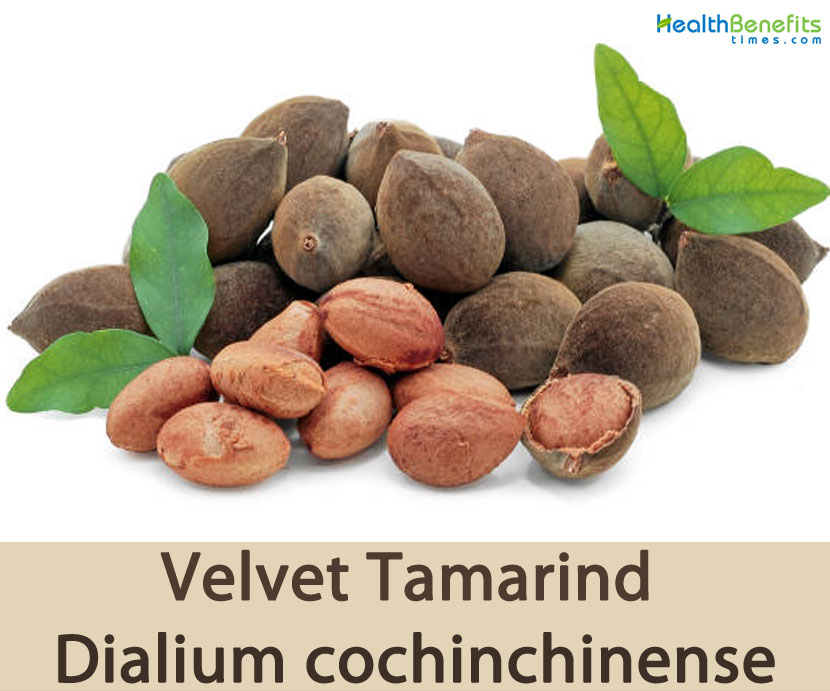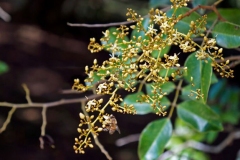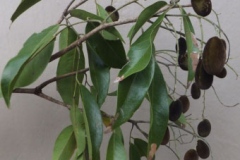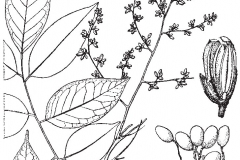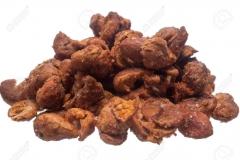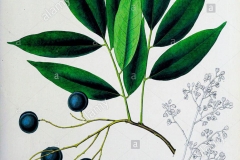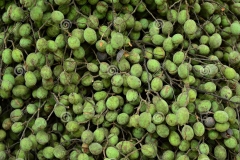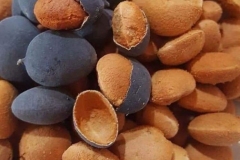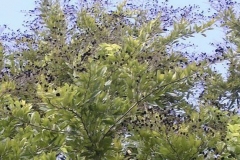| Velvet Tamarind Quick Facts | |
|---|---|
| Name: | Velvet Tamarind |
| Scientific Name: | Dialium cochinchinense |
| Origin | Ghana, Sri Lanka, Cambodia, Laos, Malaysia, Myanmar, Nigeria, Thailand, Vietnam and many west African countries |
| Colors | Light green when young becoming black when mature. |
| Shapes | Pod, ovoid, slightly laterally compressed, 1.5 cm long and 0.8-0.9 cm wide, finely pubescent to velvety |
| Flesh colors | Yellowish |
| Taste | Sweet-sour, astringent flavor similar to baobab, but sweeter |
| Health benefits | Treats Ulcer and Prevents Hypertension, Cures malaria, Improves Oral hygiene and cures Toothache, Anti-inflammatory and Anti-microbial Properties, Jaundice and Diabetes Management, Reliefs Menstrual Cramp and stops Diarrhea, Hemorrhoids (Piles), Treats Scurvy and Wounds, Improves lactation and checks genital infections, Increases the Antioxidant Capacity of the body, Treats gastric ulcer, Prevents hypertension, Cures toothache, Relieves menstrual cramps, Boosts immune system, Improves lactation, Treats wound, Lowers cholesterol level, Maintains good digestion, Maintains good metabolism, Cures dry eyes, Prevents anemia, Useful for pregnant women, Treats bronchitis, Maintains healthy kidney, Lowers body temperature, Fights harmful microorganisms, Prevent constipation, Regulate cell functions |
| Name | Velvet Tamarind |
|---|---|
| Scientific Name | Dialium cochinchinense |
| Native | Ghana, Sri Lanka, Cambodia, Laos, Malaysia, Myanmar, Nigeria, Thailand, Vietnam and many west African countries. The velvet tamarind can also be found in West African countries such as Ghana where it is known as Yoyi, Sierra Leone, Senegal, and Nigeria where it is known as Awin in Yoruba, Icheku in Igbo and Tsamiyar kurm in Hausa |
| Common Names | Velvet-tamarind, Sierra Leone-tamarind, West African Velvet Tamarind |
| Name in Other Languages | Central Khmer: Kraleanh (ក្រឡាញ់) English: Velvet-tamarind, Sierra Leone-tamarind, West African Velvet Tamarind Laos: Kheng Malaysia: Keranji Portuguese: Velvet Tamarind Sinhalese: Galsiyam̆balā (ගල්සියඹලා) Tamil: Kaṭu puḷi (கடு புளி) Thai: H̄yī (หยี), Lūkh̄yī (ลูกหยี) Vietnamese: Xoay, la met |
| Plant Growth Habit | Tropical, medium-sized, fruit-bearing, deciduous tree |
| Growing Climates | Dense evergreen and semi-deciduous forest, transitional forest between evergreen and open dipterocarp forest, savannah forests, shadowy canyons, gallery forests, riverian forest of the savannah woodland, in coastal scrub, riparian vegetation, lowland, evergreen, humid or dry forests |
| Soil | Prefers well-drained soil like alluvial soil e.g. along river or stream banks. |
| Plant Size | Up to 25-35 m height and 80-100 cm diameter |
| Bark | Bark grey to whitish, exuding a little transparent resin which turns red upon exposure. Inner bark are brownish |
| Trunk | Trunk straight, slightly buttressed at base |
| Leaf | Alternate, imparipinnately compound with 5-9 ovoid leaflets, 4-7 cm long, 1.5-3.5 cm wide, coreaceous, glabrous, base rounded, apex acuminate |
| Flowering season | September to October |
| Flower | Inflorescence paniculate, 20-30 cm long, pubescent with many flowers. Flowers small, with short flower tube |
| Fruit Shape & Size | Pod, ovoid, slightly laterally compressed, 1.5 cm long and 0.8-0.9 cm wide sized, finely pubescent to velvety |
| Fruit Color | Light green when young becoming black when mature |
| Flesh Color | Yellowish |
| Seed | One hard, flat, round, brown seed, typically 7-8 millimeters across and 3 millimeters thick. The seed somewhat resembles a watermelon seed |
| Taste | Sweet-sour, astringent flavor similar to baobab, but sweeter |
| Plant Parts Used | Fruits, leaves |
| Season | October to January |
| Health Benefits |
|
| Precautions |
|
Flower
Inflorescence is paniculate, 20-30 cm long, pubescent with many flowers. Flowers are small, with short flower tube. Flowering normally takes place in between September to October.
Fruit
Fertile flowers are followed by an ovoid, slightly laterally compressed, indehiscent pod that is 18 – 20 mm long and 13 – 15 mm wide. Each fruit typically has one hard, flat, round, brown seed, typically 7-8 millimeters across and 3 millimeters thick imbedded in a yellowish, sticky, sweet and edible substance. The seed somewhat resembles a watermelon seed. Some have two seeds. The seeds are shiny, coated with a thin layer of starch. There are 220-240 fruits per liter and 830-850 fruits per kg.
Fruits are mature when they have taken a blackish color and the fruit flesh is sweet. Fruits are harvested by shaking or breaking fruit bearing branchlets with long handled tools e.g. in connection with climbing or from the ground. The pulp is edible and may be eaten raw or soaked in water and consumed as a beverage. The bitter leaves are ingredients in a Ghanaian dish called domoda.
Health benefits of Velvet tamarind
Pulp of the fruit is edible and sweet, rich in vitamin C, sodium, iron, magnesium and potassium. It is used as flavor in snacks and non-alcoholic beverages. Different parts of velvet tamarind plant have been scientifically proven to offer a wide range of health benefits, some of them are explained below:
1. Treats Ulcer and Prevents Hypertension
Leaves extract of velvet tamarind has the ability to increase gastric mucus secretion. Therefore, a decoction of the leaves can be a remedy for gastric ulcer. Leaves are also highly diuretic and promote the production of urine, making it easier for the heart to pump blood hence, reducing the risk of hypertension.
2. Cures malaria
Velvet tamarind is used to cure malaria. Decoction of black velvet tamarind has an ability to inhibit the growth of plasmodium falciparum which is the main cause of malaria. Therefore the malaria patient will be quickly recovered.
3. Improves Oral hygiene and cures Toothache
The stem is used as chewing stick (indigenous tooth brush) which consists of saponin which adds cleaning effect to the teeth and at the same time removes plaques and caries on the teeth of users. The stem bark decoction is also used to treat tooth ache.
4. Anti-inflammatory and Anti-microbial Properties
Fruit pulp consists of abundant vitamin C which fights against microbial infections. Stem bark has the ability to reduce inflammation in bronchial tubes that arises due to bronchitis.
5. Jaundice and Diabetes Management
Decoction of velvet tamarind leaves is used in preparing medicinal solution for curing jaundice. It also lowers blood sugar and increases insulin sensitivity hence, can be used to treat diabetes.
6. Regulate cell functions
Potassium found in noticeably quantity in tamarind is an important component of cell and body fluids that helps control heart rate and blood pressure. It ensures a good cardiovascular health.
7. Hemorrhoids (Piles)
Piles are swollen veins in the anal canal caused by too much pressure in the pelvic and rectal areas and while not life threatening, these veins can be very painful. Research performed on ethanolic leaves extract of velvet tamarind showed it to be beneficial for pile treatment.
8. Treats Scurvy and Wounds
Fruit pulp has high ascorbic acid content which is an anti-scurvy vitamin hence used as food supplement. Tender leaves of velvet tamarind, when squeezed and applied on wounds, encourages the growth of healthy skin and protects the wounds against germs and moisture.
9. Improves lactation and checks genital infections
Several researches have concluded that chewing the fruit pulp increase secretion of milk as well as check infections.
10. Increases the Antioxidant Capacity of the body
Oxidative damage which involves free radicals – highly reactive molecules with unpaired electrons, is supposed to be one of the mechanisms behind ageing and many diseases. Abundance of antioxidants in the leaves helps protect the human body from damage caused by these free radicals.
11. Treats gastric ulcer
Velvet tamarind helps human health to treat gastric ulcers. Velvet tamarind increases gastric mucus secretion to care gastric ulcer and protect colon from the cancer cell. Intake should be in the recommended serving amount.
12. Fights harmful microorganisms
Velvet tamarind has pulp and seed in it, each part has its own benefits for health. For example the pulp, it has strong antimicrobial to fight against many harmful microorganisms.
13. Prevent constipation
The fruit help prevents constipation because of the presence of dietary fiber. The dietary fiber in the food increases its bulk and augments bowel movements. The fiber also binds to toxins in the food thereby help protect the colon mucosa from cancer causing chemicals.
14. Relieves menstrual cramps
Women commonly got menstrual cramps during their period. To relieve the cramps, they usually take some analgesic medicine. As many of us don’t know that velvet tamarind can provides the natural analgesic source. Velvet tamarind has significant analgesic to relieve pains, including the pain during menstruation.
15. Boosts immune system
Antioxidant added with vitamin C is the good combination to perform the health benefit of velvet tamarind. The combination is very useful to boost immune system of our body. Therefore, long term consumption of velvet tamarind in the recommended intake will ensure the long term health from microbial and fungal infection.
16. Improves lactation
For new mothers, the amount of breast milk is very important. Sometimes they get difficulty in increasing the amount of the breast milk. However, consuming velvet tamarind might be the solution to the problem, since the fruit pulp of velvet tamarind is able to increase milk secretion.
17. Treats wound
Among all kinds of acids contained in the velvet tamarind, ascorbic acid is one of the beneficial acids for human body, particularly to treat wound. This kind of acid will protect wound form bacteria, so that it is able to prevent infection on the wound.
18. Lowers cholesterol level
Consuming velvet tamarind helps to fulfill your need of dietary fiber. The dietary fiber from the sticky pulp of velvet tamarind is very useful to reduce the bad cholesterol in the blood.
19. Maintains good digestion
Related to the digestive system, the benefit of velvet tamarind you can take is the supply of the dietary fiber. The dietary fiber is able to increase bulk and bowel movement, so that we are able to prevent constipation. It is also able to bind toxin from the digested food and protect the digestive organs.
20. Maintains good metabolism
Velvet tamarind is rich of vitamins including thiamin, vitamin A, folic acid, niacin, riboflavin, and the most important is vitamin C. Besides act as antioxidant to fight free radicals, these vitamins also help the function for enzyme metabolism of human body.
21. Cures dry eyes
According to a research, the compound contained in the velvet tamarind decoction is similar to the mucin in the eye. Mucin is the good mucus for our body. This fluid is in charge to protect and moistures cornea. Thus, the velvet tamarind’s compounds is now planned to be used as one of the ingredients for eye drop as the treatment for dry eyes.
22. Prevents anemia
Velvet tamarind consists of ample amount of iron. Amount of iron in the velvet tamarind is able to boost red blood production that is needed to prevent anemia.
21. Useful for pregnant women
It is amazing that this tiny fruits actually has anti-aborifacient component. It prevents abortion for pregnancy. Therefore, it is suggested for women with the new pregnancy, as it will strengthen the pregnancy. It also encloses vitamin A which is beneficial for pregnancy.
22. Treats bronchitis
According to research, velvet tamarind helps to treats respiratory problems such as bronchitis. Bronchitis patient can treat the disease with velvet tamarind.
23. Maintains healthy kidney
Velvet tamarind is a good diuretic. Velvet tamarind is able to bind the toxin and optimize the urine excretion in the kidney. It will also prevent the kidney stones disease.
24. Lowers body temperature
Velvet tamarind has been used for the traditional aid to lower body temperature. People from long ago soaked velvet tamarind into water, and drink the water to reduce fever.
Traditional uses and benefits of Velvet Tamarind
- Bark and leaves have medicinal properties and are used against several diseases.
- Leaf’s decoction is used to solve problems of gastric ulcer.
- Leaves possess a lot amount of diuretic properties helping in producing urine, also helps the heart to pump blood thus eradicating the complications of hypertension.
- Bark decoction has medical applications to solve tooth ache.
- Bark lowers the inflammation from the bronchial tubes solving bronchitis.
- Leaves decoction is also used in the treatment of jaundice, regulates the blood sugar levels by reducing the sugar levels and strengthens the insulin sensitivity thus curing diabetes.
- Pre mature leaves of the velvet tamarind fruits are used to heal the wounds thus promoting the skin and guard it from problems like germs and moisture.
- Root-bark is used for the treatment of coughs.
- Bark for treating stomatitis and also toothache.
Culinary Uses
- Sweet pulp of the fruit is edible.
- Ripened fruits are mixed with sugar and chili peppers, wrapped in thin plastic sheets and sold in markets as a dessert.
- Bark is occasionally used as a masticatory – as a substitute for Areca in betel quid.
- In South eastern Nigeria children eat the tender leaves as wild vegetable snack especially on the way to and from the stream and farm.
- Fruit is used as a candy-like snack food in Thailand, often dried, sugar-coated and spiced with chili.
- The thirst-quenching, refreshing fruit pulp can also be soaked in water and drunk as a beverage.
Other Facts
- It is harvested from the wild for its timber, which is also used locally.
- Tree is occasionally planted as a fruit-bearing and shade tree.
- Brown dye is obtained from the bark.
- Wood is used as timber for construction (doors, windows), boat-building and daily utensils.
- Wood is suitable for heavy construction, flooring, handles for striking tools and batons.
- Tree is also used as firewood and charcoal.
- Wood is used for vehicles, houses and flooring.
References:
https://plants.usda.gov/core/profile?symbol=DIGU2
https://www.itis.gov/servlet/SingleRpt/SingleRpt?search_topic=TSN&search_value=506249#null
http://germoplasma.iniaf.gob.bo/gringlobal/taxonomydetail.aspx?id=405657
http://tropical.theferns.info/viewtropical.php?id=Dialium+cochinchinense
https://forskning.ku.dk/soeg/result/?pure=files%2F20543915%2Fdialium_cochin_91_int.pdf
https://en.wikipedia.org/wiki/Dialium_guineense


